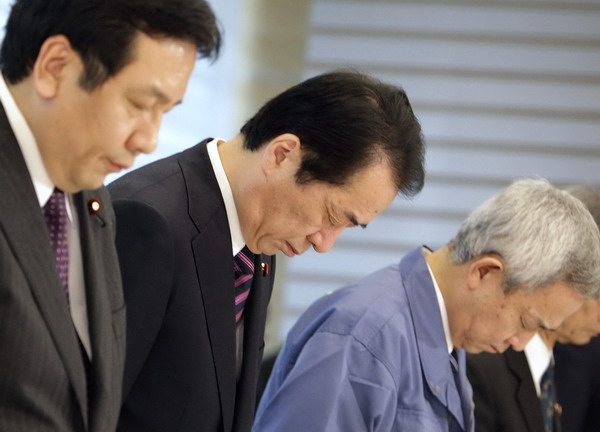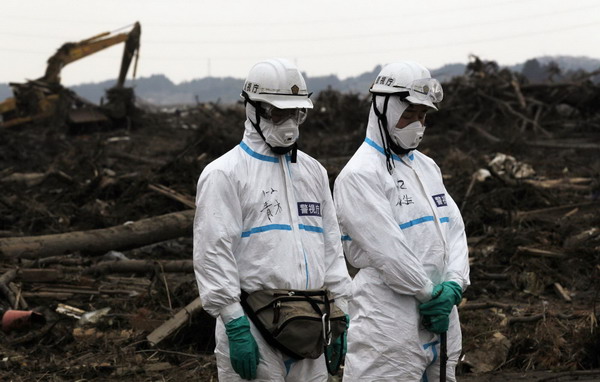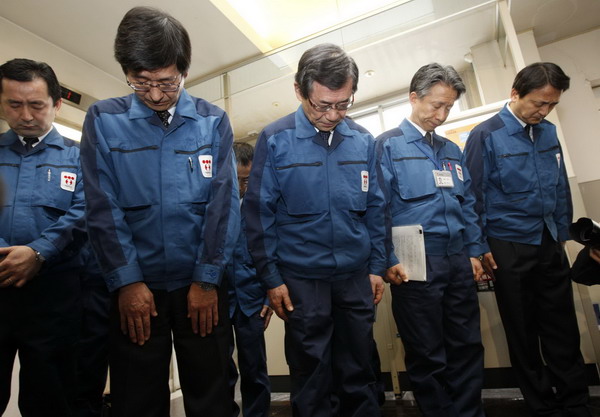Latest News
Japan falls silent a month after tsunami
(chinadaily.com.cn)
Updated: 2011-04-11 17:16
 |
Large Medium Small |
FUKUSHIMA, Japan -- Sirens wailed and people bowed their heads and wept along Japan's devastated northeast coast Monday as they marked a month since the tsunami that killed up to 25,000 people and unleashed a persistent nuclear crisis.
With thousands of bodies yet to be found, a tsunami-flooded nuclear power plant still spewing radiation and more than 150,000 people living in shelters, there was little time for reflection on Japan's worst disaster since World War II.
"My chest has been ripped open by the suffering and pain that this disaster has caused the people of our prefecture," said Yuhei Sato, the governor of Fukushima, which saw its coastal areas devastated by the tsunami and contains the damaged plant at the center of the nuclear crisis. "I have no words to express my sorrow."
People in hard-hit towns gathered for ceremonies at 2:46 p.m., the exact moment of the magnitude-9.0 quake that spawned the tsunami March 11.
In a devastated coastal neighborhood in the city of Natori, three dozen firemen and soldiers removed their hats and helmets and joined hands atop a small hill that has become a memorial for the dead. Earlier, four monks in pointed hats rang a prayer bell there as they chanted for those killed.
The noisy clatter of construction equipment ceased briefly as crane operators stood outside their vehicles and bowed their heads.
In the industrial town of Kamaishi, Iwate Gov. Takuya Tasso led a moment of commemoration as a loud siren rang through a high school gymnasium being used as a shelter. He bowed while people who have lived there since the tsunami kneeled on makeshift futons, bowed their heads and clasped their hands.
Students will start school at the shelter Tuesday even though 129 people are living in their gym. Some, like 16-year-old Keisuke Shirato, wore their baseball uniforms for Monday's ceremony. Shirato's family was not affected by the tsunami, but about half of his teammates lost their homes.
"A new school year starts tomorrow," Shirato said. "Hopefully that will help give people hope and allow them to look toward a new start."
The earthquake and tsunami flattened communities along hundreds of miles (kilometers) of coastline, causing what the government estimates could be as much as $310 billion in damage. More than 158,000 people are still without electricity and 210,000 have no running water, although some of that is because of a 7.1-magnitude aftershock that rattled the area last week.
"Even after a month, I still cry when I watch the news," said Marina Seito, 19, a student at a junior college who recalled being in a basement restaurant in Sendai when the earthquake hit. Plates fell and parts of the ceiling crashed down around her.
Adding to the misery is radiation spewing from the Fukushima Dai-ichi nuclear complex 140 miles (220 kilometers) northeast of Tokyo, which lost its cooling systems when water from the tsunami washed over it.
Government officials have ordered the 70,000 to 80,000 people who live within 12 miles (120 kilometers) to leave, and those farther from the plant may also be told to evacuate as the crisis drags on.
"We have no future plans. We can't even start to think about it because we don't know how long this will last or how long we will have to stay in these shelters," said Atsushi Yanai, a 55-year-old construction worker. The tsunami spared his home, but he has to live in a shelter anyway because it is in the evacuation zone.
Nuclear safety official Hidehiko Nishiyama apologized for the worry and inconvenience caused by the radiation spilling from the plant, where cooling systems still have not been restored and likely won't be for several months. Contamination leaking into the ocean and into soil has raised concerns about the safety of food including fish, vegetables and milk.
"It's still difficult to give a timeline regarding when we can resolve the problem," Nishiyama said Monday. "We are very sorry for the evacuees who are anxious to see the problem resolved."
| 分享按钮 |


